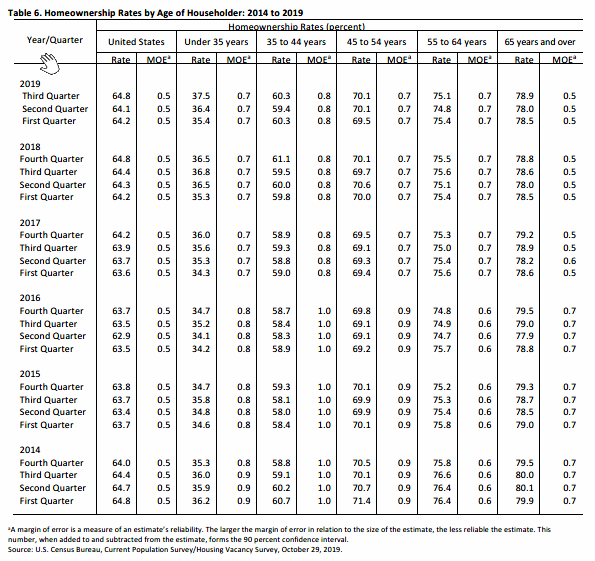
An interesting story related to real estate in 2019 is the re-emerging popularity and rise of the suburbs. Reporting by the Wall Street Journal (American Suburbs Swell Again as a New Generation Escapes the City ![]() ) highlights the economic and infrastructure impacts of this changing trend. This news appears to have an interesting demographic component: the increased popularity for suburban housing is being driven by millennials. Indeed, another article from the WSJ (Millennials Continue to Leave Big Cities
) highlights the economic and infrastructure impacts of this changing trend. This news appears to have an interesting demographic component: the increased popularity for suburban housing is being driven by millennials. Indeed, another article from the WSJ (Millennials Continue to Leave Big Cities ![]() ) notes that:
) notes that:
Cities with more than a half million people collectively lost almost 27,000 residents age 25 to 39 in 2018, according to a Wall Street Journal analysis of the figures. It was the fourth consecutive year that big cities saw this population of young adults shrink. New York, Chicago, Houston, San Francisco, Las Vegas, Washington and Portland, Ore., were among those that lost large numbers of residents in this age group.
Millennials, also known as Generation Y, are the demographic born between 1981 and 1996. Previously, the public narrative had been that millennials preferred central urban housing and were waiting to get married, have children, and buy real estate. When you take a closer look at who is buying real estate, the facts show that the narrative is changing and millennials are starting to prefer suburban housing.
The US Census Bureau reports data on the homeownership rate, which represents the “proportion of households that are owners.” They also track homeownership rates by age of householder ![]() . The table below, from the most recent quarterly report, shows the homeownership rate by age of householder from 2014 to 2019 by the following age groups: all age groups, under 35 years, 35 to 44 years, 45 to 54 years, 55 to 64 years, and 65 years and over.
. The table below, from the most recent quarterly report, shows the homeownership rate by age of householder from 2014 to 2019 by the following age groups: all age groups, under 35 years, 35 to 44 years, 45 to 54 years, 55 to 64 years, and 65 years and over.

The table shows the homeownership rate by age of householder from 2014 to 2019 by the following age groups: all age groups, under 35 years, 35 to 44 years, 45 to 54 years, 55 to 64 years, and 65 years and over.
The data shows that homeownership rates over the past five years have been steady near 64% (64.8% as of the end of the 3rd quarter). The data also clearly shows that the only age group with increasing home ownership over this period of time is the “under 35 years” demographic (millennials), with 37.5% of them owning real estate as of the end of the 3rd quarter.
Combined, the reporting and data demonstrate that millennials are driving the increased demand for housing. It appears that the narrative is changing — millennials are no different than their parents and, much as before, are favoring suburbs as they are finally getting married, having children, and buying real estate.
Washington Trust Bank believes that the information used in this study was obtained from reliable sources, but we do not guarantee its accuracy. Neither the information nor any opinion expressed constitutes a solicitation for business or a recommendation of the purchase or sale of securities or commodities.
Nick is a Vice President and Portfolio Manager for Washington Trust Bank’s Wealth Management & Advisory Services. He offers our clients the expertise to analyze portfolios and unique assets to ensure that they are suitable for meeting our clients’ goals and needs. Nick partners with our Relationship Managers to provide continual analysis to ensure that these customized portfolio solutions maintain the balance between risk and growth in order to ensure continued success in meeting the clients’ goals.